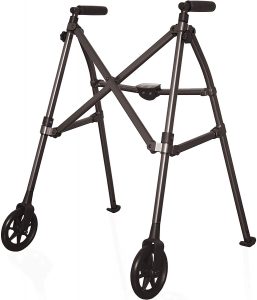
The name of this walker says it all. It does not take up a lot of space in the users living area or in a car because it can be easily folded. It comes equipped with non-swivel front wheels and back wheels which helps the user to travel over different types of surfaces. This walker can be used at a height of up to 400 lbs.
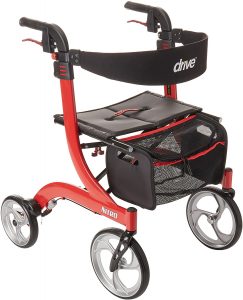
Rated as the best rollator walker, it comes equipped with great safety features such as non-visible brake cable, and a pouch attachment that stays in place whether the rollator is opened or closed. The large wheels are ideal for indoor and outdoor use. The frame is easy to fold while also providing great support.
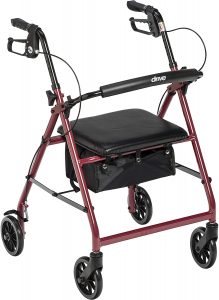
This rollator is cost effective and favored among users. This rollator has many great features including padded seats, zippered pouch to store personal items, removable backrest, loop locks and brakes. The tires make it excellent for both outdoor and indoor use.
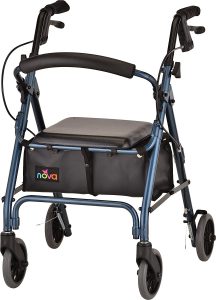
Petite and infrequent users will find this rollator to be a great choice. The padded seats, locking hand brakes, flip-up back, 6′ wheels, and fold-ability are several of its great features.
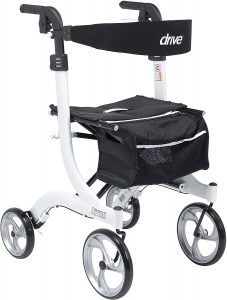
This rollator is comfortable and convenient and is the best rollator for tall users.
It’s easy to use because of its durability and flexibility and the frame is made from lightweight aluminum. Its large wheels make it ideal for users who need to maneuver both indoor and outdoor terrain. The customized back support and height handle is a true convenience.
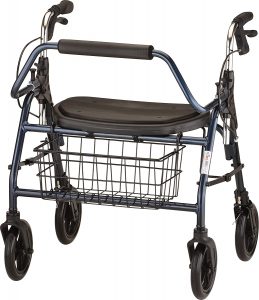
The Mighty Mack rollator is built to support heavier users and is also ideal for average to tall users. The extra wide seat is its greatest feature.
Common Rollator Types
Users looking for flexibility when walking should choose the three- wheeled rollator. They have one wheel in front and two wheels in back and are best used indoors. The front wheels make it easier to maneuver tight spaces. They are narrow, lightweight, and easy to transfer and store while also offering limited balance, don’t come with seats but may come with a storage bag.
Wheelchairs can be manual or self-propelled as well as motorized or powered for self-navigation. Manual rollator wheelchairs are lightweight and cost-effective. On average, they weigh 35 to 40 pounds and lightweight wheelchairs weigh 27 to 35 pounds. The weight capacity for standard wheelchairs is between 250 to 300 pounds. They are excellent for long-term and frequent use. Users who have upper-body strength can improve their overall health because navigating them provides exercise.
Motor rollator wheelchairs are more expensive than manual wheelchairs because they are equipped with motors and seats giving users the ability to move about more freely. Some motor wheelchairs have joysticks which provide further directional travel capability. The electric wheelchairs is the best rollator for outdoor use.
Power rollator wheelchairs can weigh between 150 to 400 pounds. 3 wheel wheelchair can be stylish and yet practical because users can charge the motor, store items, and travel at their leisure.
Users requiring more stability should choose the four-wheeled rollator. They provide reliable back support and also come with seats for resting and a storage basket or pouch.
Larger individuals can also use rollators. The bariatric rollator provides support for individuals up to 500 lbs. They are built stronger, better and heavier (up to 26 lbs). Users can be confident that these rollators provide durability for higher weights because the chair won’t sink when rolling over soft ground due to the larger wheels.
This lightweight walker wheelchair combo provides flexibility for users and an added sense of independence when using it. Users can choose to walk on their own or be pushed by someone else.
Rollators versus Walkers
The purpose of rollators and walkers are for independence in movement. They provide individuals and seniors with the ability to move around freely and easily. Individuals can also use rollators or walkers to assist them with balance issues.
Walkers come in wheeled and non-wheeled varieties and are best used on indoor surfaces. N on-wheeled walkers are usually standard walkers or walking frames. Individuals should choose a walker based on their particular use. The proper way to use the walker is to pick it up and move it forward in order to maintain contact with the ground while walking. Proper use of the walker will provide the user with continued support to prevent slips and falls.
Wheeled walkers, on the other hand, are best for outdoor use, users can move forward without having to pick it up. They are equipped with two front wheels and rubber stoppers on the back wheels which provide additional support. If used indoor, users should be careful when maneuvering over carpets.